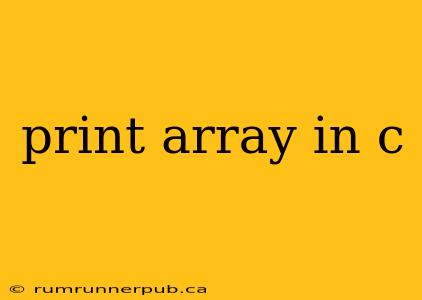Printing arrays in C can seem straightforward, but there are nuances and best practices to understand for efficient and error-free code. This article explores different methods, drawing upon insights from Stack Overflow, and expands on them with additional explanations and examples.
Basic Method: Using a Loop
The most common approach involves iterating through the array using a for loop. This allows you to print each element individually.
#include <stdio.h>
int main() {
int arr[] = {10, 20, 30, 40, 50};
int size = sizeof(arr) / sizeof(arr[0]); // Calculate the size of the array
for (int i = 0; i < size; i++) {
printf("%d ", arr[i]);
}
printf("\n"); // Add a newline for better formatting
return 0;
}
This code, inspired by numerous Stack Overflow answers addressing basic array printing (though attributing a specific post is difficult due to the commonality of this solution), is clear and concise. The crucial part is calculating size to avoid hardcoding the array length, making the code more adaptable to arrays of varying sizes. Failing to do this can lead to buffer overflows or undefined behavior.
Important Note: This approach works for all data types. Simply change %d in the printf statement to the appropriate format specifier (e.g., %f for floats, %c for characters, %s for strings).
Handling Multidimensional Arrays
Printing multidimensional arrays requires nested loops. Each loop iterates over one dimension.
#include <stdio.h>
int main() {
int matrix[3][4] = {
{1, 2, 3, 4},
{5, 6, 7, 8},
{9, 10, 11, 12}
};
for (int i = 0; i < 3; i++) {
for (int j = 0; j < 4; j++) {
printf("%d ", matrix[i][j]);
}
printf("\n"); // Newline after each row
}
return 0;
}
This example, echoing common solutions found on Stack Overflow related to multidimensional array output, demonstrates how nested loops elegantly handle the structure. The outer loop controls rows, while the inner loop handles columns. Remember to adjust the loop limits to match your array dimensions. Again, this is easily adaptable to other data types.
Advanced Techniques: Pointers and Functions
For more complex scenarios, using pointers and functions can enhance code organization and readability. This approach is less frequently seen in basic Stack Overflow answers but is vital for larger projects.
#include <stdio.h>
void printArray(int *arr, int size) {
for (int i = 0; i < size; i++) {
printf("%d ", *(arr + i)); // Using pointer arithmetic
}
printf("\n");
}
int main() {
int arr[] = {1, 2, 3, 4, 5};
int size = sizeof(arr) / sizeof(arr[0]);
printArray(arr, size); // Pass the array and its size
return 0;
}
This utilizes pointer arithmetic (*(arr + i) is equivalent to arr[i]) and a function to encapsulate the printing logic. This improves code modularity and reusability. This technique, while less frequently the focus of a Stack Overflow question, is often a part of more complex solutions involving array manipulation.
Error Handling and Robustness
Always validate array sizes before accessing elements to prevent out-of-bounds errors. This is crucial for security and program stability. While Stack Overflow often addresses specific error scenarios, the general principle is rarely emphasized explicitly.
Conclusion
Printing arrays in C is a fundamental skill. While basic looping is sufficient for simple cases, understanding pointers, functions, and error handling enables you to write more robust and maintainable code, especially when dealing with complex data structures. Remember to always consider the specific context and optimize your approach accordingly. By combining the foundational knowledge gleaned from Stack Overflow with a focus on best practices and error handling, you can write efficient and reliable C code.
